With eleven caps for Wales and various transfers to different environments, Rabbi Matondo (175cm/5’9”, 66kg/145lbs) is a 21-year-old with plenty of experience already. After departing Cardiff City’s academy for Manchester City at the age of 16, Matondo displayed good performances in teams involving Barcelona’s Eric García, Leverkusen’s Jeremie Frimpong, and Wolfsburg’s Felix Nmecha to name a few. Starting the 2018/19 season brilliantly, terrorising defences at Premier League 2 level and in the EFL Trophy, Schalke 04 paid a reported £8m fee for the Welshman.
However, this move to Germany has not fulfilled the initial hopes for both the club and the player. Matondo struggled to cement a starting role, lacking consistent minutes as he was deployed all across the front line. Meanwhile, Schalke transitioned from Champions League qualification to Bundesliga relegation. Joining Stoke City on loan for the second half of the 2020/21 season, Matondo experienced Championship football whilst his parent club were relegated from the Bundesliga. Once again, he encountered sporadic game time on the right-wing, his potential position at Rangers.
Last season was much improved for The Gers’ new signing. Top scorer for loan club Cercle Brugge in the Belgian Pro League, Matondo notched up over 2,000 league minutes as a key player in the Groen en Zwart team that secured a midtable position. In this tactical analysis in the form of a scout report, we will take a look at Rabbi Matondo’s style of play and influence at Cercle Brugge, alongside assessing his suitability for Giovanni van Bronckhorst’s Rangers.
Versatility
Matondo is a right-footed forward with the versatility to play several positions in the attack and wide areas. As mentioned above, his role at Stoke was often on the right-wing in a 4-2-3-1. Matondo also played as the wing-back in a 3-5-2, a role he’s played before for Manchester City in the 2017/18 UEFA Youth League. However, this is not his strongest position and is highly unlikely to be seen at Rangers. At Schalke, he frequently operated as a shadow striker/attacking midfielder off a more physical target man like Guido Burgstaller or Michael Gregoritsch. His appearances for Wales are similar to club level, with inconsistent minutes spread across multiple positions, mainly used in the forward line.
At Cercle Brugge, Matondo has played his best and most consistent football at senior level. Mainly deployed as a left-winger, he has experienced different approaches and formations from managers Dominik Thalhammer and Yves Vanderhaeghe.
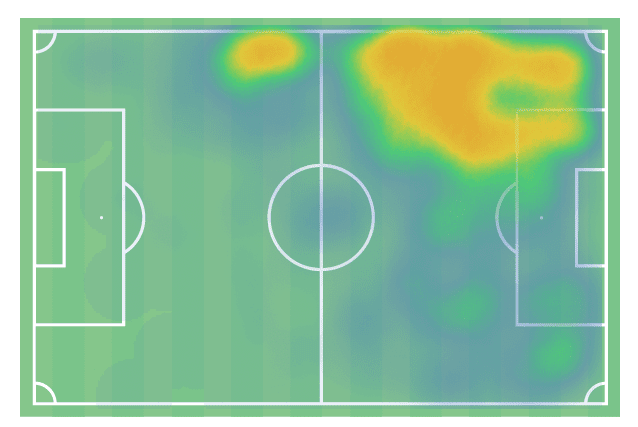
As the above heatmap from Matondo’s 2021/22 season shows, he occupies spaces on the left wing and naturally drifts inside as a right-footer. However, one of Matondo’s strengths displayed last season was his fitness levels, which allowed him to play different roles in different games. From his 23 league starts, Matondo completed 19 full nineties. Combining his endurance with his pace, another strength of his, meant he was often moved across the attack to centre-forward and right-winger in the latter stages of matches. Here, he would utilise his dynamism to relentlessly stretch opposition defences and attempt to exploit weaknesses in the final minutes.
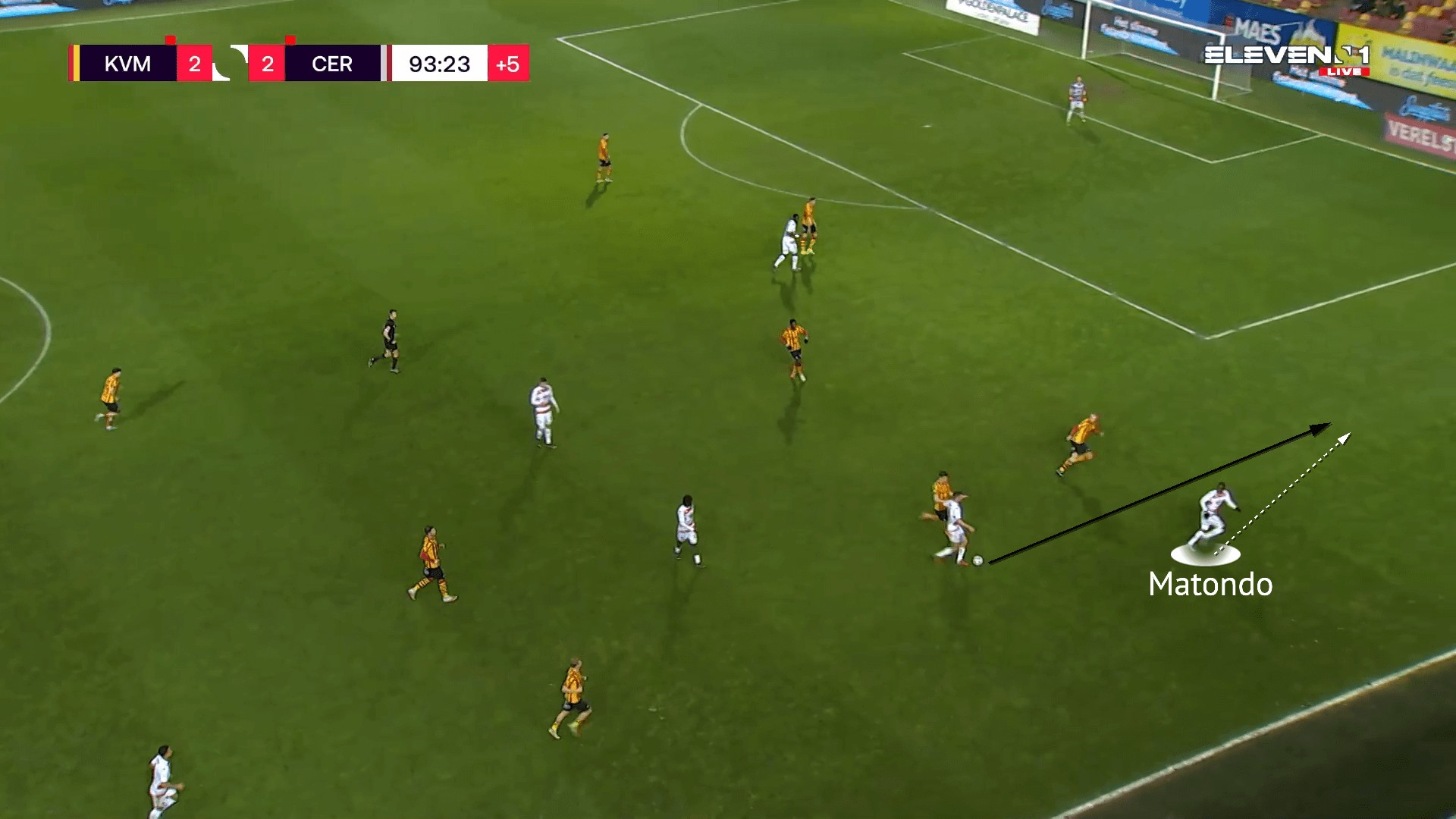
The figure above is an example against Mechelen, where Matondo initially started as a left-winger. Drifting wide to the right, he has drawn out and isolated the opponent. He then used his pace to drive past the defender with his dribbling to break into the box.
When in the box, Matondo made a rash decision to drill the ball across the face of the goal rather than finding striker Kévin Denkey in the six-yard box. In the image below, Matondo has penetrated the Netherlands’ defensive line. Jordan Teze is the deepest of the back three, playing Matondo onside, but is out of the picture. Stefan de Vrij and Bruno Martins Indi, the two remaining centre-backs, are leaving Matondo and Teze one-on-one for the lofted pass in behind from Tottenham’s Joe Rodon.
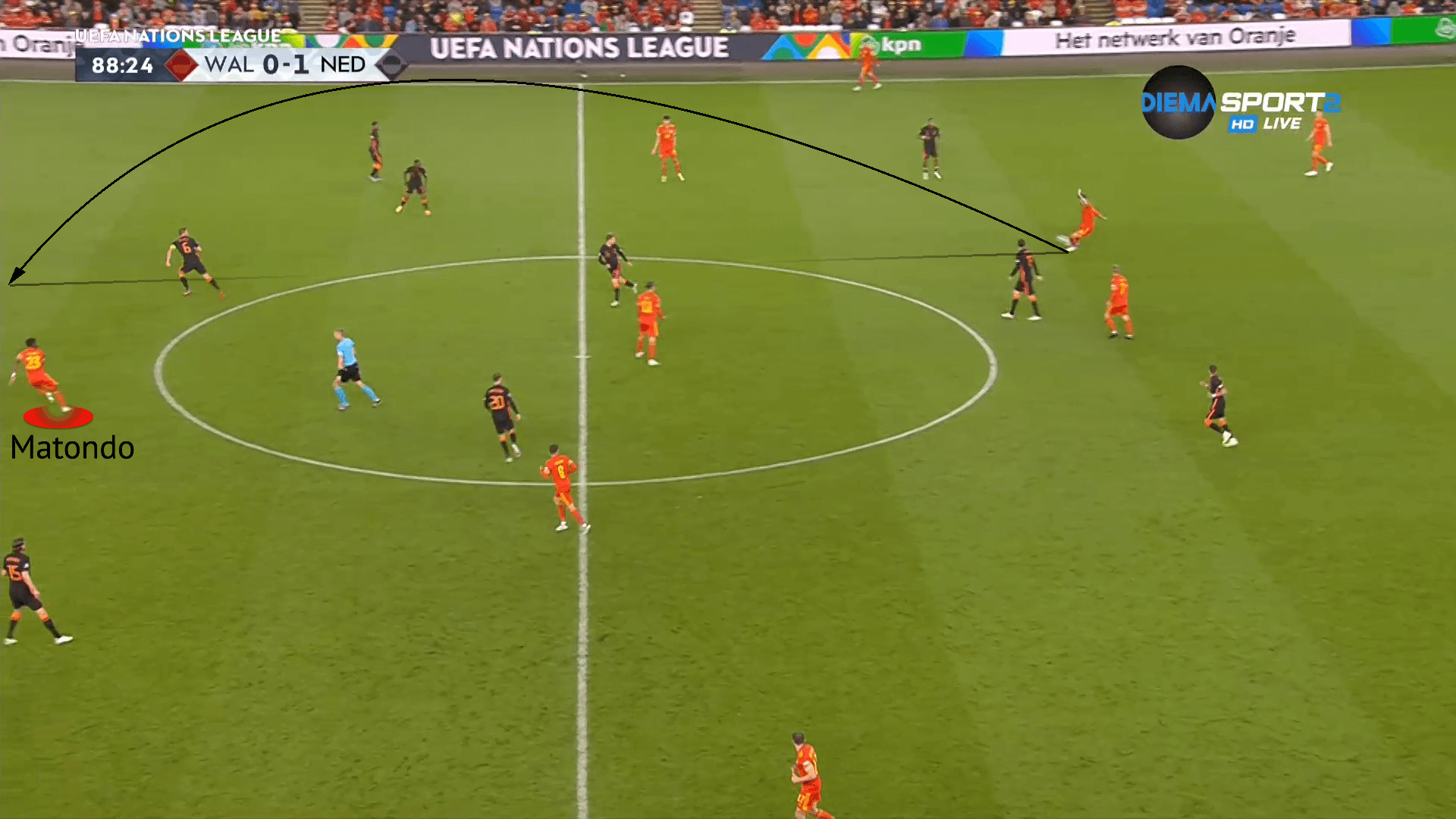
Dynamic dribbling
Matondo’s frightening pace alongside his dribbling ability made him one of the most dangerous players in possession in the Belgian Pro League last season. With 8.51 dribbles per 90, the Wales international ranked 4th in the league for that statistic out of the 334 players to have played over 700 minutes. Although his success rate of 44.93% is about league average, he displayed different techniques in different scenarios with success.
Completing 3.58 progressive runs per 90, ranking 17th in the division, Matondo can effectively carry possession from deeper areas to progress. These are particularly impactful during attacking transitions.
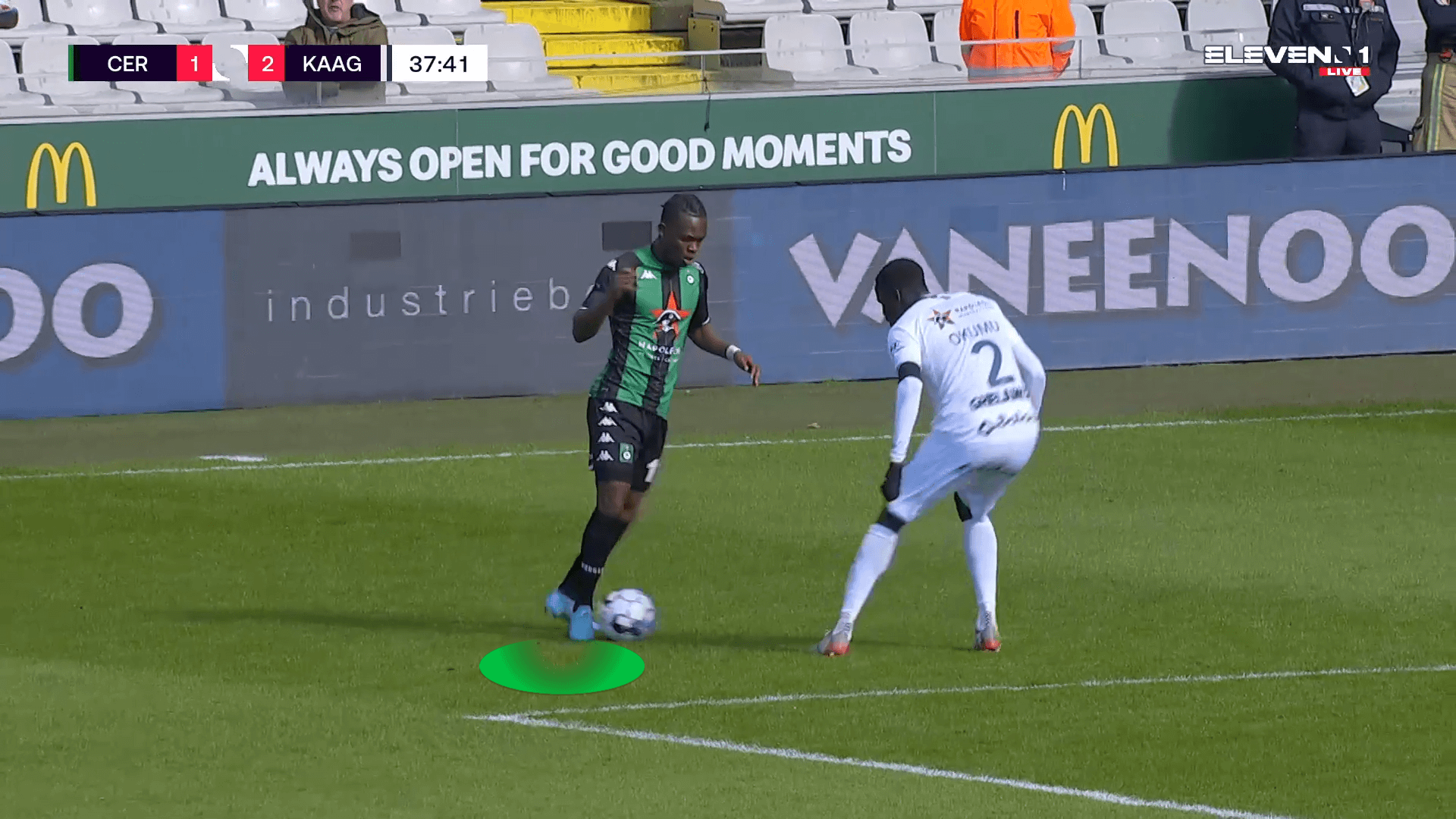
With his pace superiority over defenders, Matondo is capable of beating his man from a standing start or even with the opponent having a couple of yards advantage. In the image above, Matondo is facing up Gent’s Joseph Okumu, one of the division’s leading defenders. Drawing the centre-back in after dramatically slowing his pace, Matondo feinted inside like a right-footer on the left-wing would to shift Okumu’s weight inside. He then burst down the wing to the touchline gaining separation from Okumu and forcing the defender to commit to a sliding block. With Matondo heavily right-footed, he cut back with a fake shot and had a shot blocked rather than attempting a left-footed cross.
Matondo tends to take multiple touches when dribbling in an attempt to find the optimal shooting opportunity. It is rare that he effectively takes larger touches to create space for his pace due to some technical limitations regarding the inconsistent weight of touches. His first touch can get stuck under his feet or bounce away from him, but he can regularly use his pace and acceleration to retain possession and move away from the opposition or win a foul.
Matondo is fairly weak with his back to goal and the congestion in central areas can prevent him from productively exercising his quickness. Physically, his SAQ excellence is levelled out by more delicate strength that can see him get ushered away from goal and off the ball.
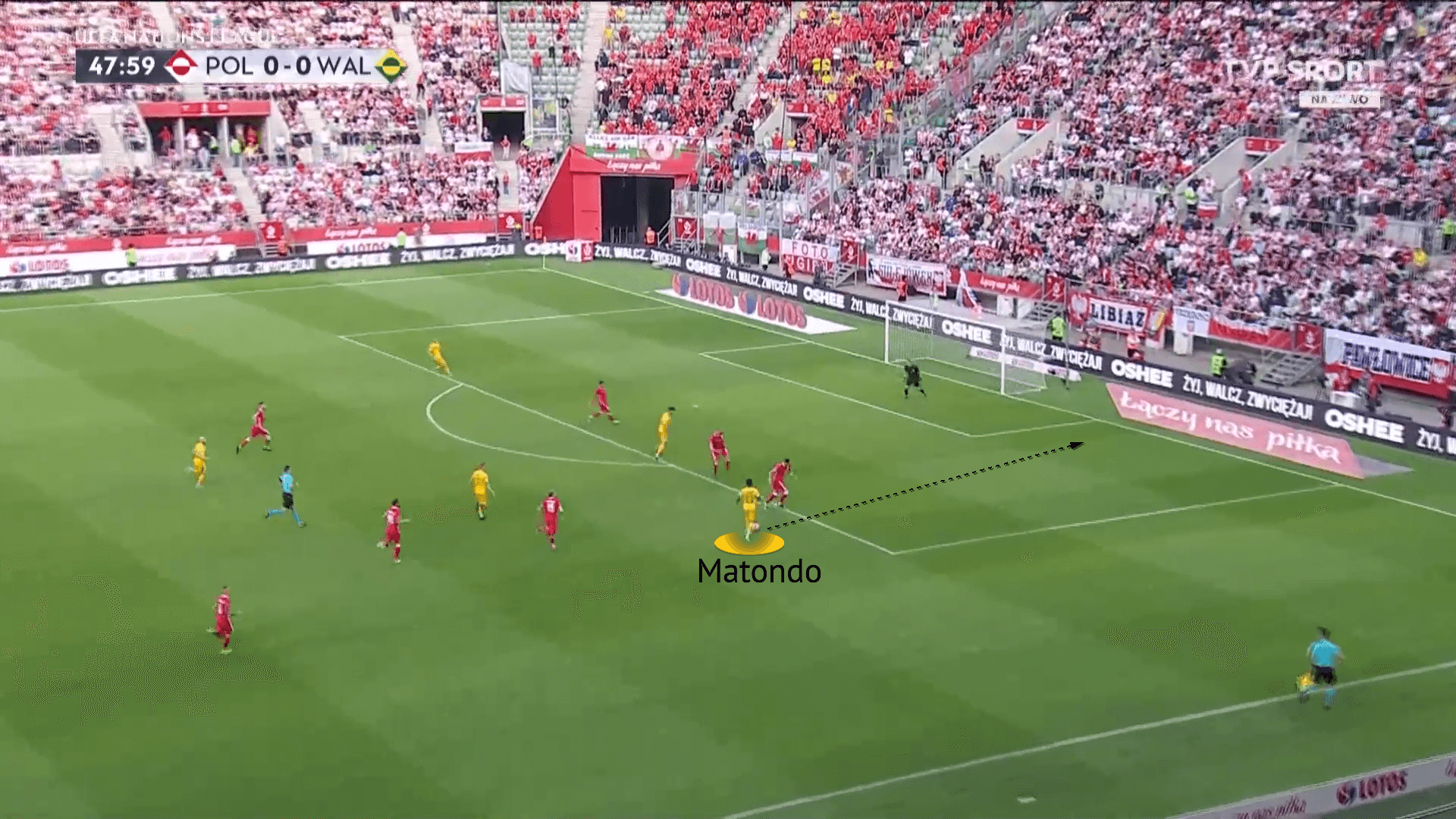
The figure above is the type of situation on the right-wing where Matondo flourishes. Receiving the ball with a gap between the nearest defender, he can quickly accelerate to attack the back-tracking defender at pace. In these situations, Matondo will rely on body feints to beat the defender rather than more complex skills and ball manipulation, due to his running speed. In the example above, his feints allowed him to drive past the defender on the outside with a fake pass and change of pace creating the space for Matondo to reach the by-line and attempt a hard and low cross.
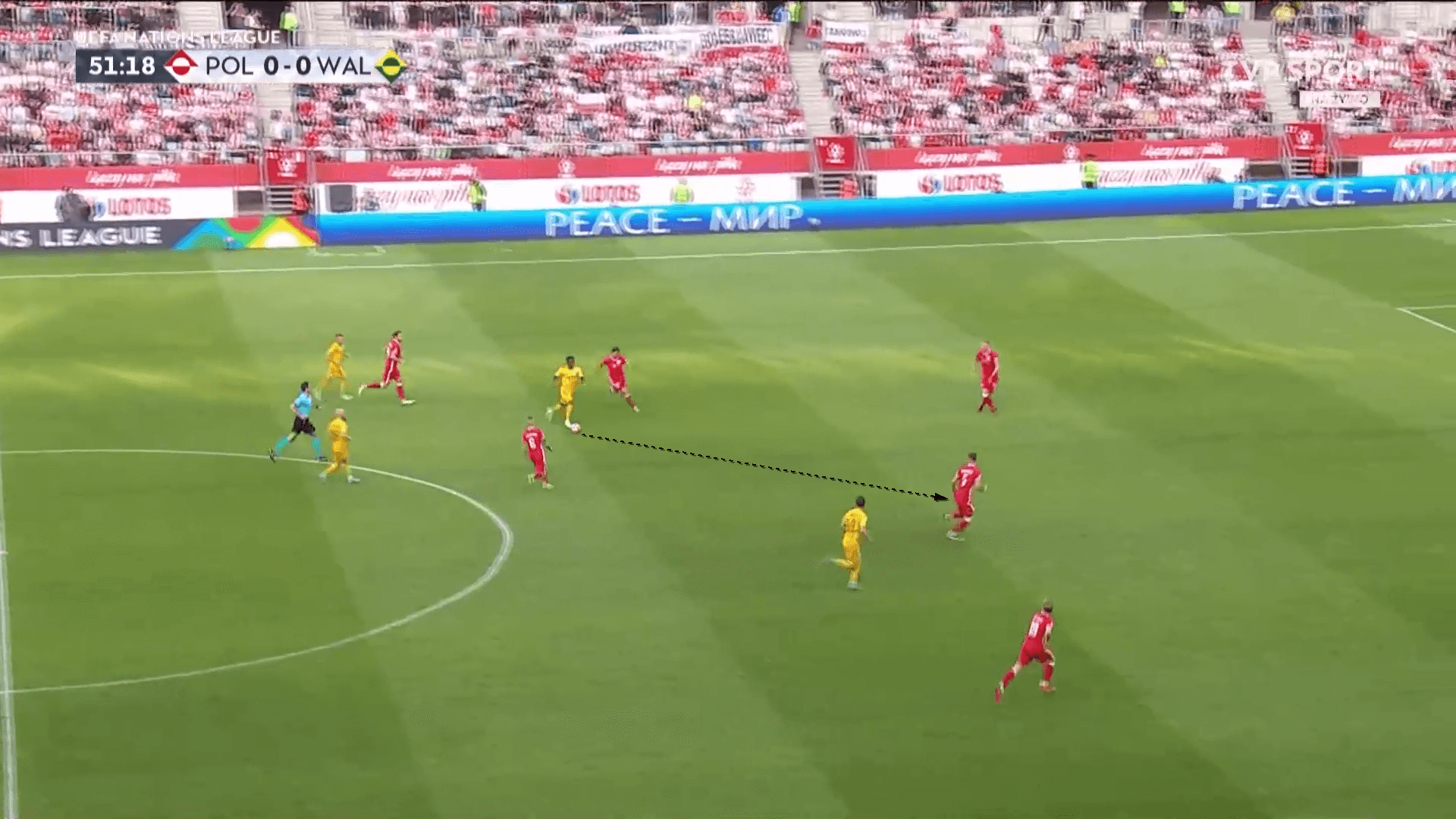
As stated above, Matondo’s dribbling and pace can be especially effective in attacking transitions. In the example above, he receives a forward pass inside the opposition half after a Joe Morrell regain. Managing to get the ball out of his feet, Matondo bursts between the two Poland players to leave them behind. As he takes more touches to continue driving at the defence, he is tackled by Southampton’s Jan Bednarek.
His pass selection in the final third could be improved, with the Welsh international also liable to dribbling with his head down. When coming off the left wing in deeper phases, Matondo often attempts the dribble between two opponents as shown above. He is confident in his ability to use his pace in such scenarios to commit multiple opponents.
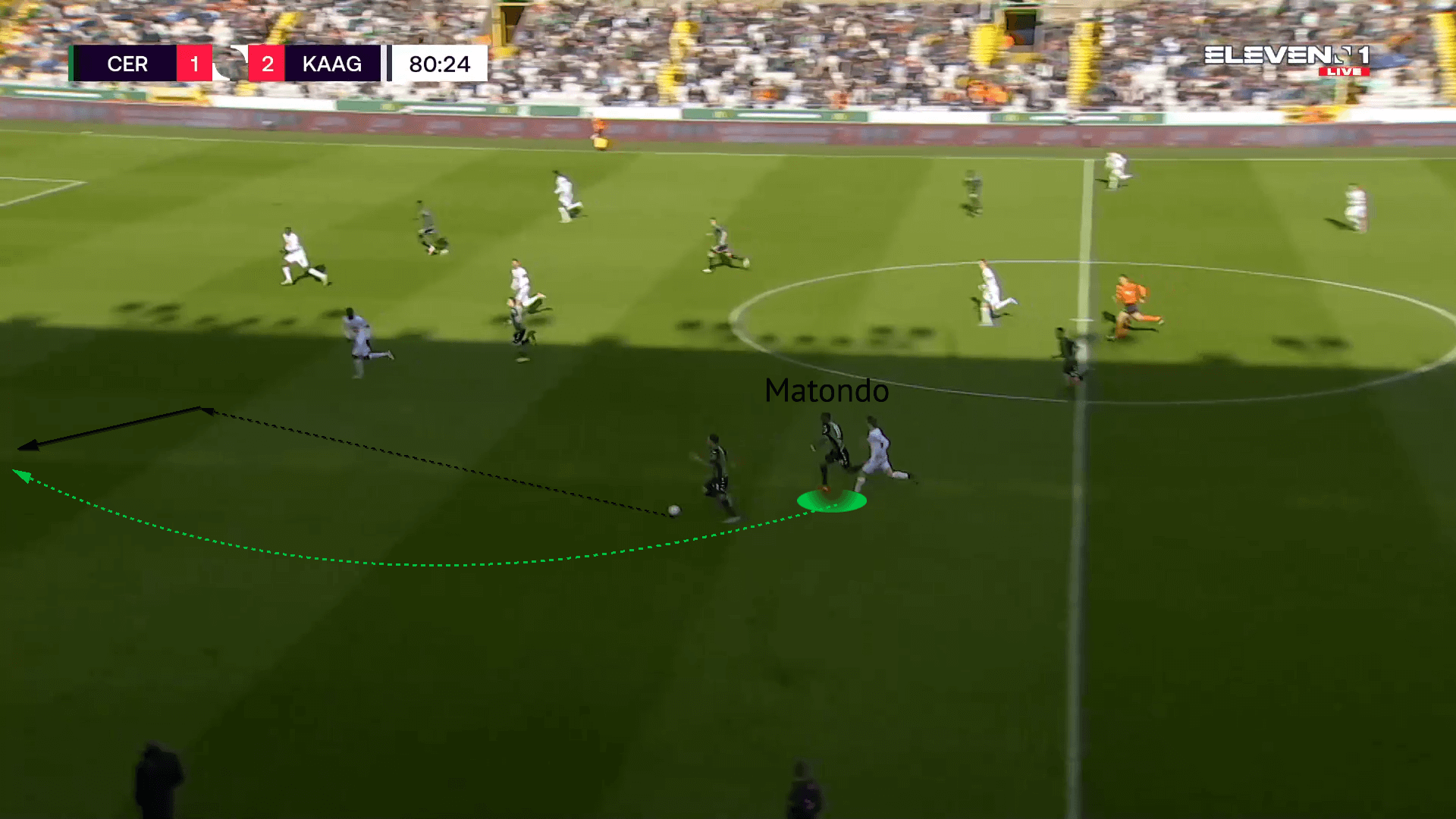
The two figures above and below show an example of his threat in transitions, whilst also displaying his aforementioned endurance to sustain his intensity in the latter stages of matches. As Vitinho breaks forward in possession, Matondo provides support from behind with an overlapping run to exploit the wide space in the defence. After Vitinho’s carry, he releases Matondo just inside the box who continues wide and plays the ball squarely with his left foot for attacker Thibo Somers to convert after getting across his man in the six-yard-box.
With his willingness to stretch play too, Matondo has the diversity of off-the-ball movement to be dangerous in transition, alongside the dribbling ability to progress and penetrate with possession. Matondo was frequently the crucial component in Cercle Brugge’s attacking transitions, and we would also expect his significance in transitions to continue at Rangers under Giovanni van Bronckhorst.
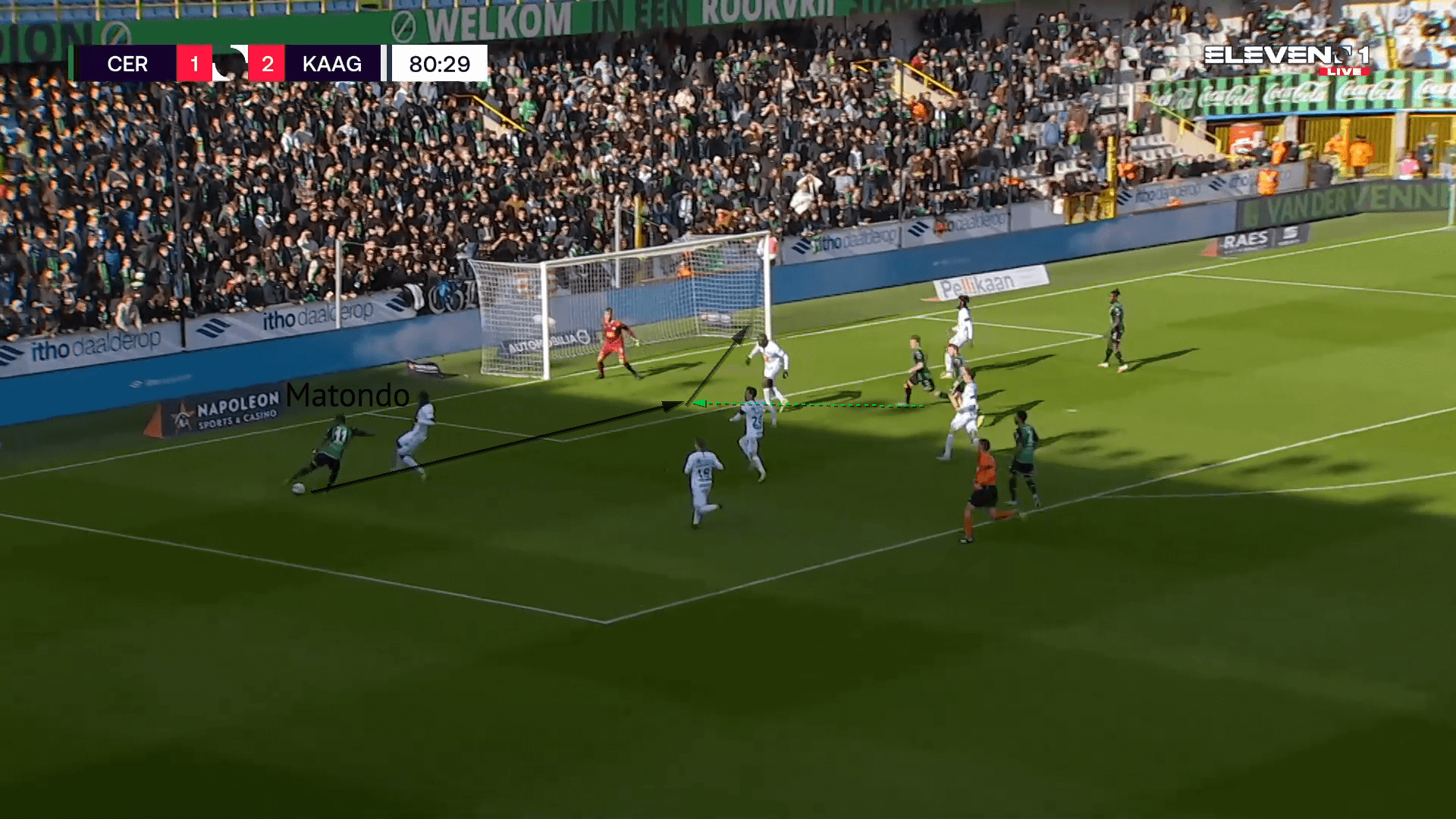
End product
Matondo is essential to Cercle Brugge’s overall attacking play, not just transitions. Rangers’ new signing scored 9 goals from 7.67 xG as the top scorer at his loan club last season. His non-penalty goals per 90 of 0.37 ranked 28th out of the 344 players with over 700 minutes in the Pro League. Matondo took the most shots at Cercle Brugge last season, and his 3.04 shots per 90 ranked 12th in the league. With 4.48 touches in the opposition penalty box per 90, he had more than his teammates and ranked 21st in the league. He is also top at the club for offensive duels per 90 with 16.67, although his success rate of 37.08% is fairly average.
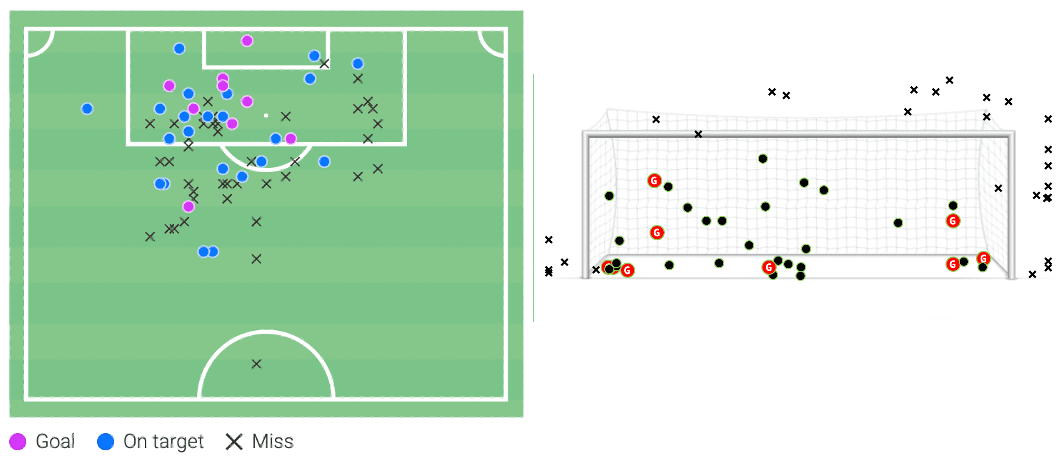
The two figures above show Matondo’s shot locations and shot placements. With Matondo generally occupying spaces on the left wing, the vast majority of his shot locations are coming inside off that wing. Something that is noticeable when combining the two figures is the placement of his goals. With the placement being spread out towards the corners of the goal, he has shown the ability to score at the near- and far-post from the shooting angles afforded off the left-wing. Additionally, all of his goals except one came from the left side of the pitch, with the other goal coming from a dribble across the box from the left.
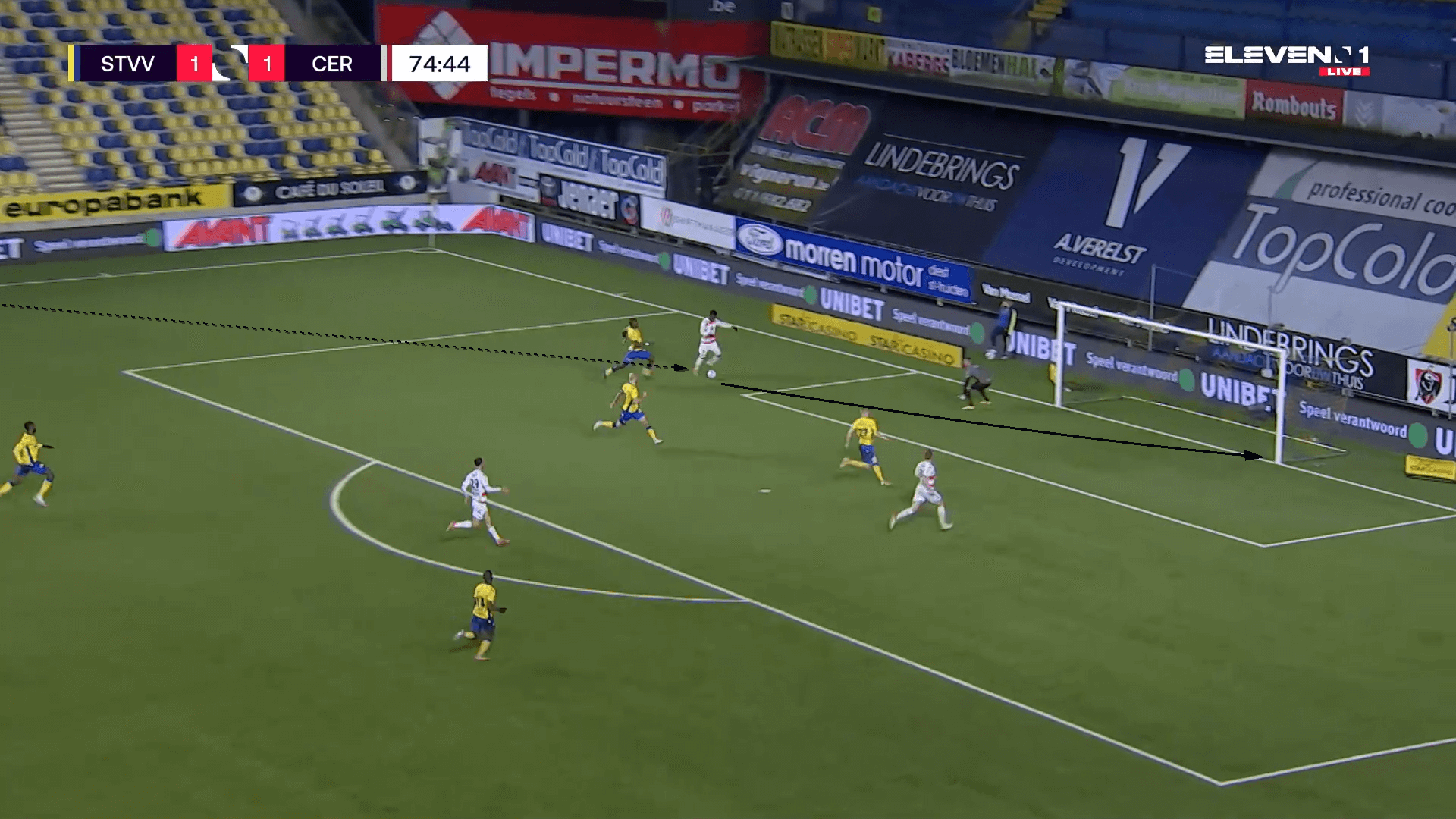
The image above is from Matondo’s goal against Sint-Truiden, where he utilises his pace and dribbling to drive past the full-back on the left wing and break into the box. From here, the Welsh international was able to slot the ball into the far corner to score the winner before receiving a late second booking. Shot placements just inside the far post are very common for right-footed left-wingers naturally cutting inside to shoot. The image below is from his goal outside the box against Anderlecht, where Matondo was able to cut inside for a shooting opportunity before unleashing a powerful strike to the far post.
As we can see from the shot locations, Matondo is not afraid of attempting the more audacious shots. He often shoots from distance after cutting inside from the left. One of his biggest weaknesses is his lack of composed ball-striking, regularly lashing out without control to generate power rather than placing the ball with more finesse. Something that must be stated is Matondo’s ability to influence games and have an impact against teams stronger than Cercle Brugge.
Of his 11 goal involvements in the league, only one came in a fixture against a team lower than Cercle Brugge in the table at the time of the fixture. With goals against Union Saint-Gilloise, Anderlecht, Genk and a phenomenal assist in a win against fierce rivals Club Brugge, he has proved to turn up in big games. Although new club Rangers will have title ambitions, his goal-scoring against strong opposition will be tested in Europe with the Gers in the draw for the third qualifying round of the UEFA Champions League.
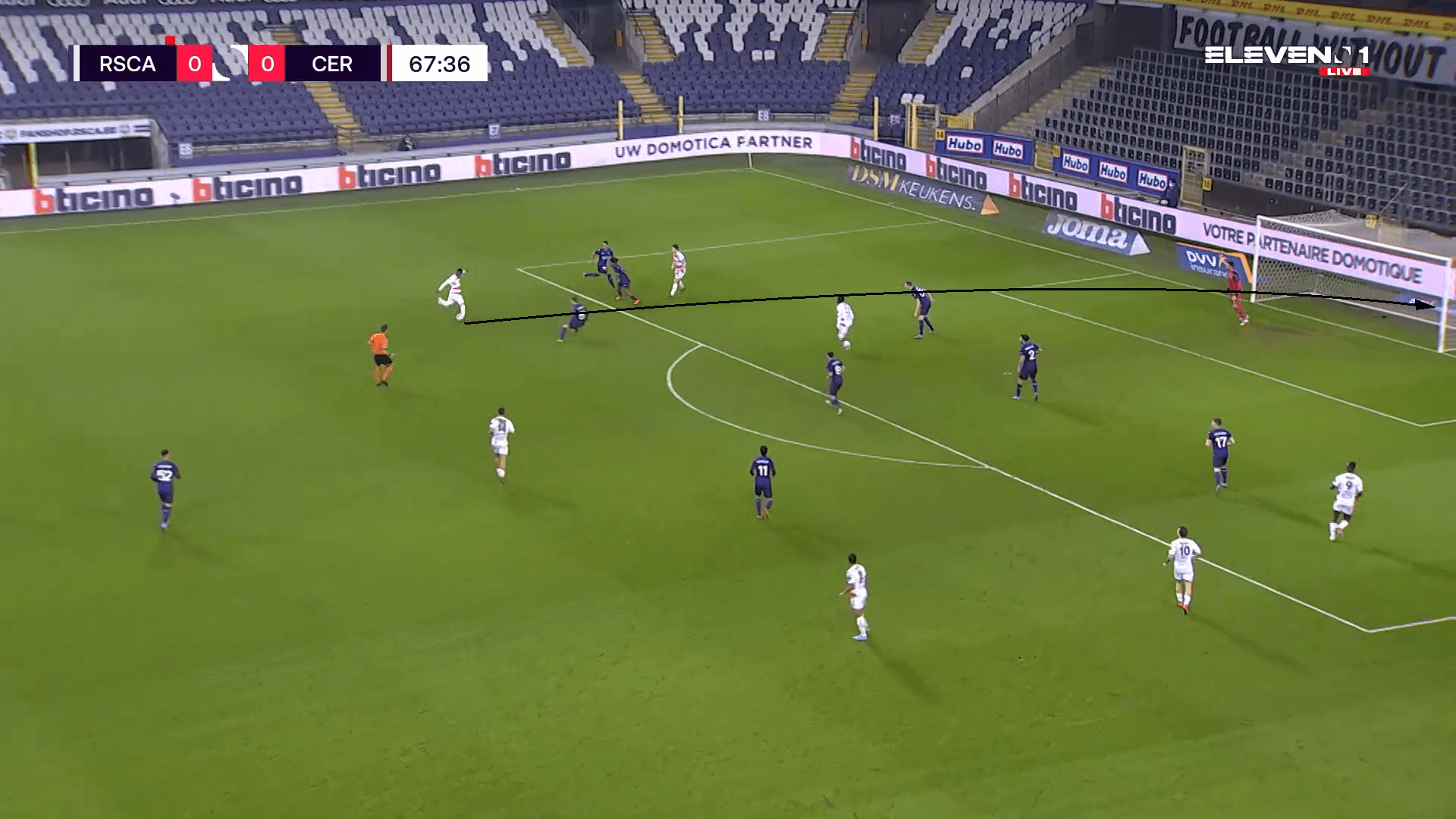
Attempting over three shots a game with some questionable decision-making when taking shots, Matondo can frustrate teammates. His tendency to take more speculative shots combined with his dribbling to work a shooting angle can prevent him from finding teammates in better positions. The Welsh international’s weight of pass is often overhit for medium and long ranged passes, which if polished would add another dimension to his devastating transitional threat.
The image below is an example of Matondo’s faulty decision-making in the final third, almost like a tunnel vision for shooting as opposed to passing. After breaking forwards and penetrating to enter the Czech Republic penalty box, he is starting to be forced wide by centre-back Tomáš Petràšek. With strike partner Brennan Johnson arriving to attack the back-post, a left-footed strike or pass across goal could create a tap-in for Johnson off a rebound or direct from the pass. Instead, Matondo attempted a right-footed outside of the foot shot to the near-post which was effortlessly saved by Jindřich Staněk.
It is common for Matondo to become greedier in the final third after successfully beating an opponent on the dribble, with the example above coming after bypassing David Zima with a dummy on the touchline in the Welsh half.
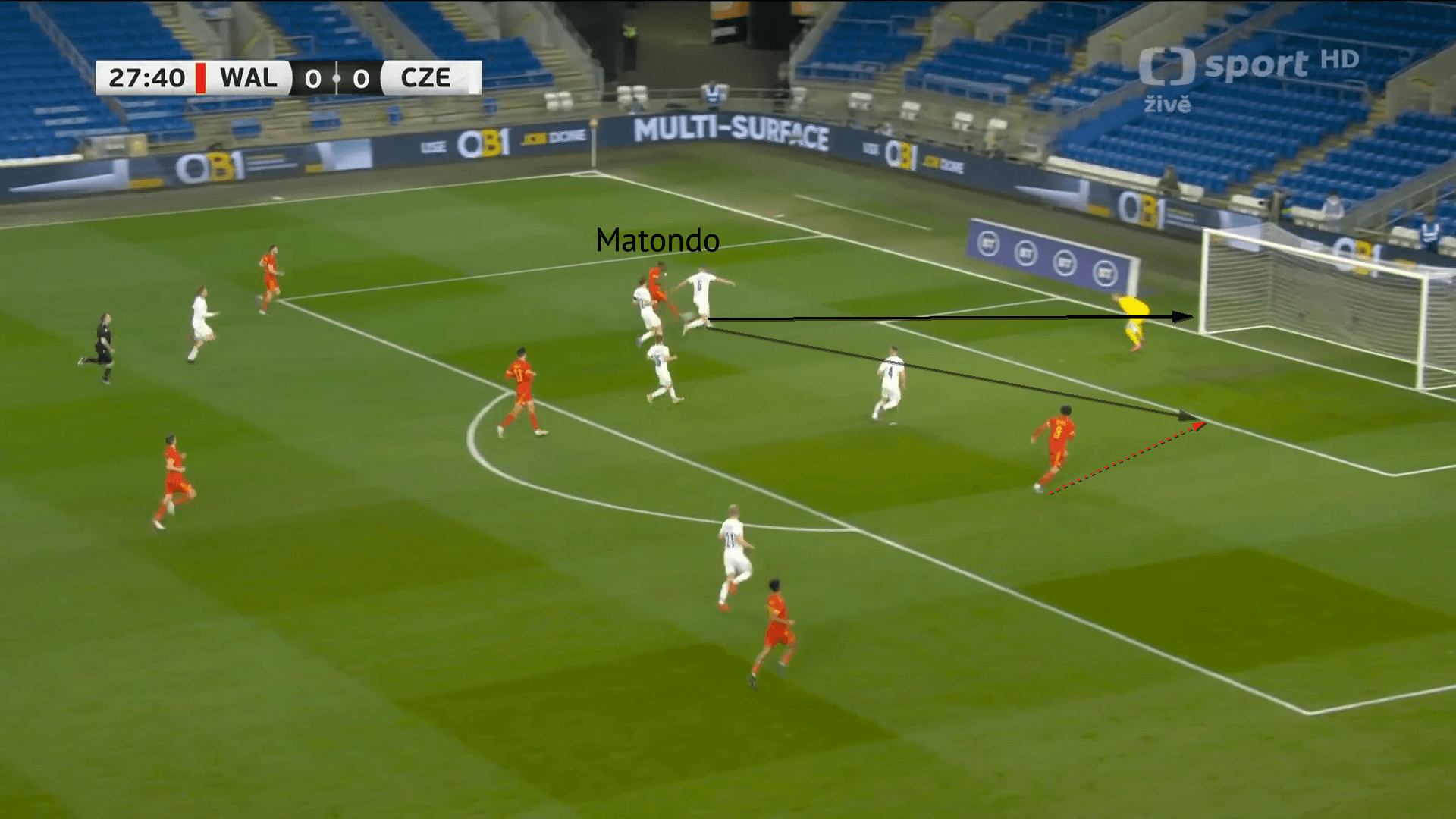
Despite this, his xA per 90 of 0.16 was the third highest at Cercle Brugge last season and ranked 43rd in the division. Matondo also ranked 2nd at the club for key passes per 90 with 0.49, which ranks him 73rd in the division. Cercle Brugge ranked 5th in the league for crosses last season, attempting 14.37 per 90. Matondo attempted the 5th most crosses at the club with 2.05 per 90, ranking him 81st in the division. His crossing accuracy of 28% is poor, but his crossing habits conflict with Cercle Brugge’s type of crossing. Despite ranking 5th in the 18-team league for crosses overall, only six teams attempted fewer crosses to the six-yard-box than Cercle Brugge. These type of hard and low crosses across the six-yard-box that can cause havoc to opposition defences are Matondo’s preference for crossing and is the opposite of Cercle Brugge’s most common type of crossing.
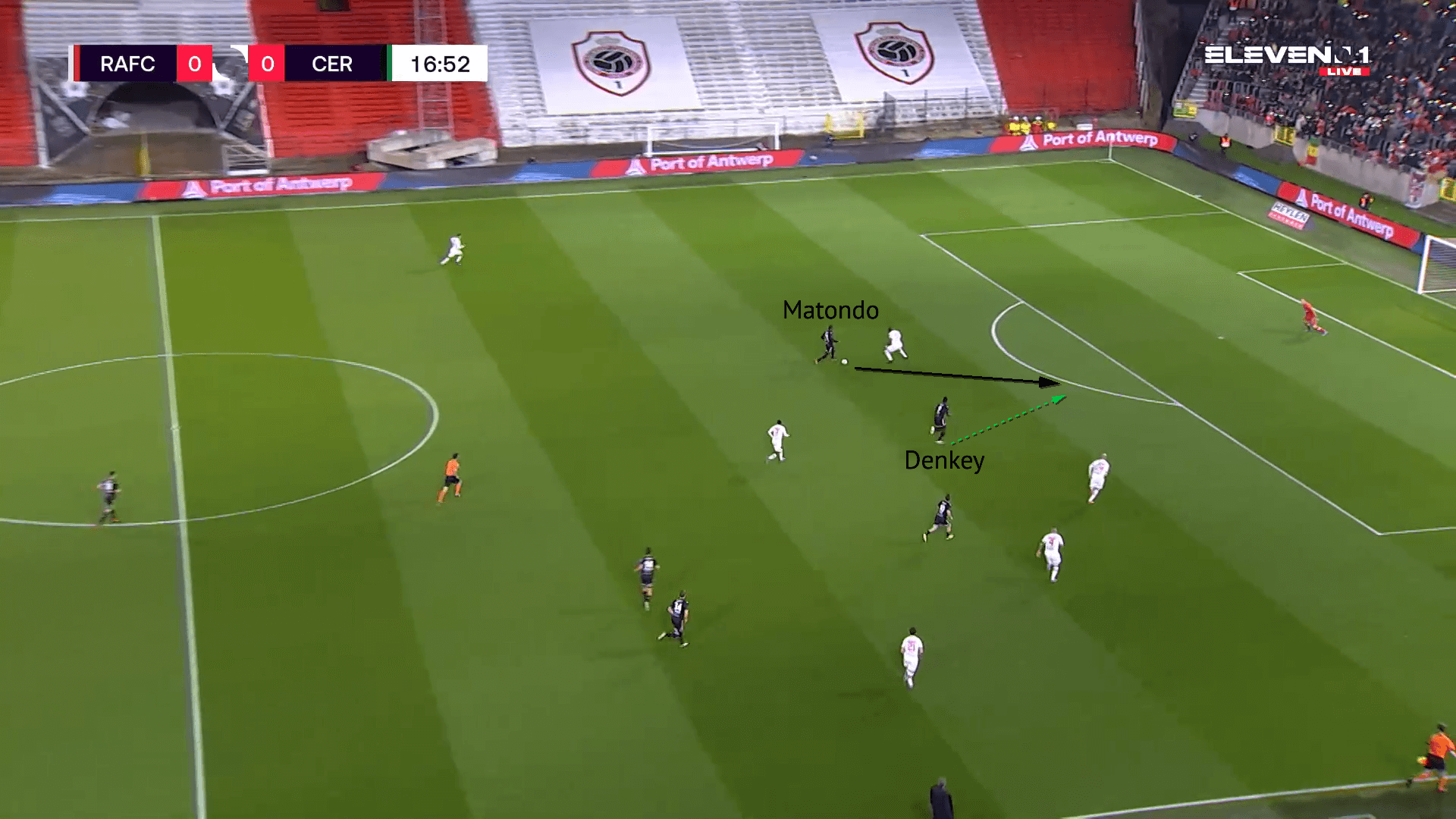
The image above displays a situation where Matondo receives a loose pass from an Antwerp defender attempting to play across the backline. Operating on the left-side of Cercle Brugge’s 4-2-3-1, he has come inside away from the Antwerp right-back and is facing up centre-back Abdoulaye Seck. With striker Kévin Denkey making the run behind Seck and uncatchable for left-sided centre-back Dorian Dessoleil, a pass would put the Togolese striker through on goal. However, Matondo attempted to beat Seck on the inside, taking a heavy touch that ran through to the Antwerp goalkeeper Jean Butez.
Matondo cannot be relied upon to be a consistent high-quality chance creator, especially in deeper phases. His 1.91 passes into the penalty area ranked 7th at Cercle Brugge, with an unimpressive accuracy of 39.58%.
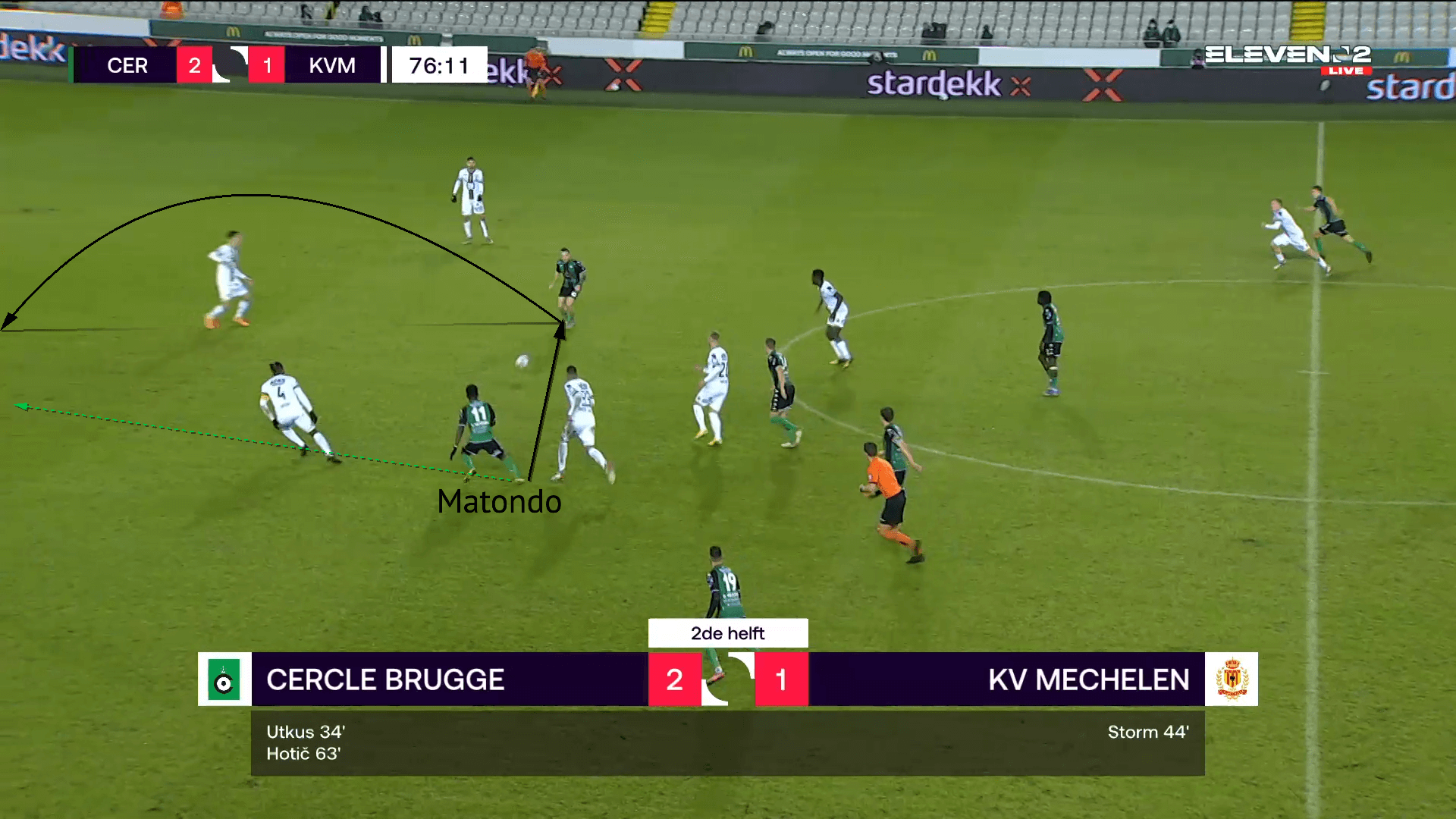
To overcome his potential passing difficulties, his responsibilities in deeper phases can lean more towards his dribbling and dynamism strengths. The figure above shows Matondo occupying the central area and dropping off to receive with his back to goal away from Mechelen centre-back Sheldon Bateau. Bateau is a defender that loves to be aggressive and touch-tight with strikers receiving with their back to goal, but Matondo dropping off has created separation and negated the Welshman’s weaknesses with his back to goal. Executing a give-and-go with teammate Dino Hotić, Matondo has drawn out Bateau and created a situation that accentuates his quickness to penetrate in behind and stresses the centre-back’s pace problems. Bursting past the Trinidad and Tobago international, Matondo coolly slotted his one-on-one past the goalkeeper into the bottom right corner.
When playing centrally in deeper phases, these situations will get the best out of Matondo. They don’t depend on his work with his back to goal, only depending on tolerable short passing accuracy to allow him to highlight his mind-blowing turn of pace to penetrate defences.
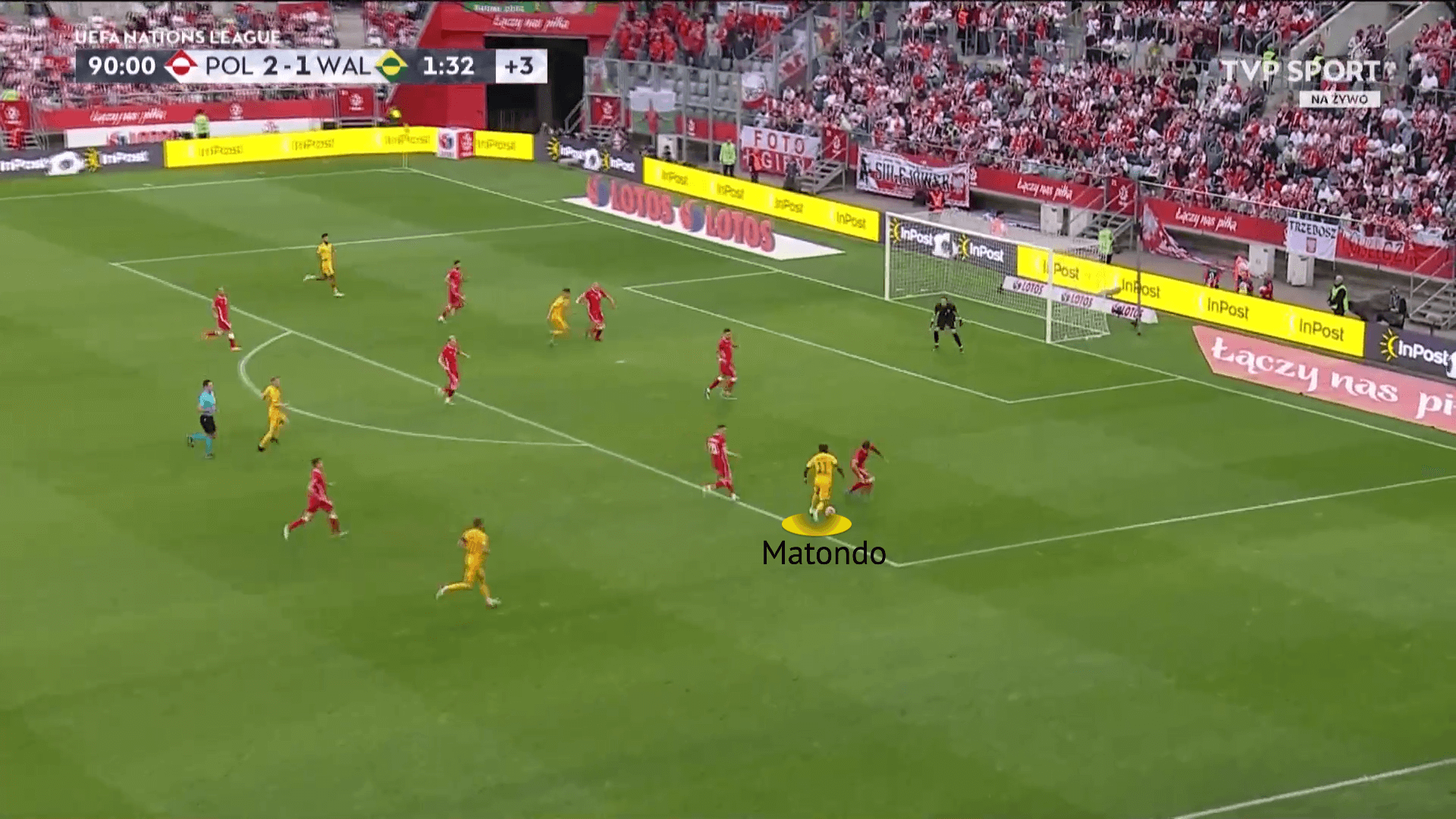
The images above and below follow on from Matondo’s deeper play, but off the wing rather than centrally. The Wales international has drifted into space on the right wing to receive a pass away from pressure. With a poor first touch under his body, he utilised his acceleration to build up speed and charge at the now retreating Poland defence.
When operating as a right-winger, the deeper situations that get the most value out of Matondo’s skill set allow him to drive at the defence with his dynamic dribbling. As he enters the box, Poland double up on him. This allows the full-back to overcompensate covering towards the by-line where Matondo wants to take the ball on his right foot, whilst the supporting midfielder covers inside. This forces Matondo to attempt to come inside, where he takes a heavy touch and is tackled before he can get a shot off.
Being so one-footed, coming off the right wing onto his left foot is naturally uncomfortable for Matondo. Alongside his minimal recent game-time on the right-wing, he has not been exposed to the angles that he could expect if deployed as a right-winger for Rangers. His right-footedness can overall make his game one-dimensional, with his first intentions on the left-wing being to cut inside and on the right-wing to get round the outside.
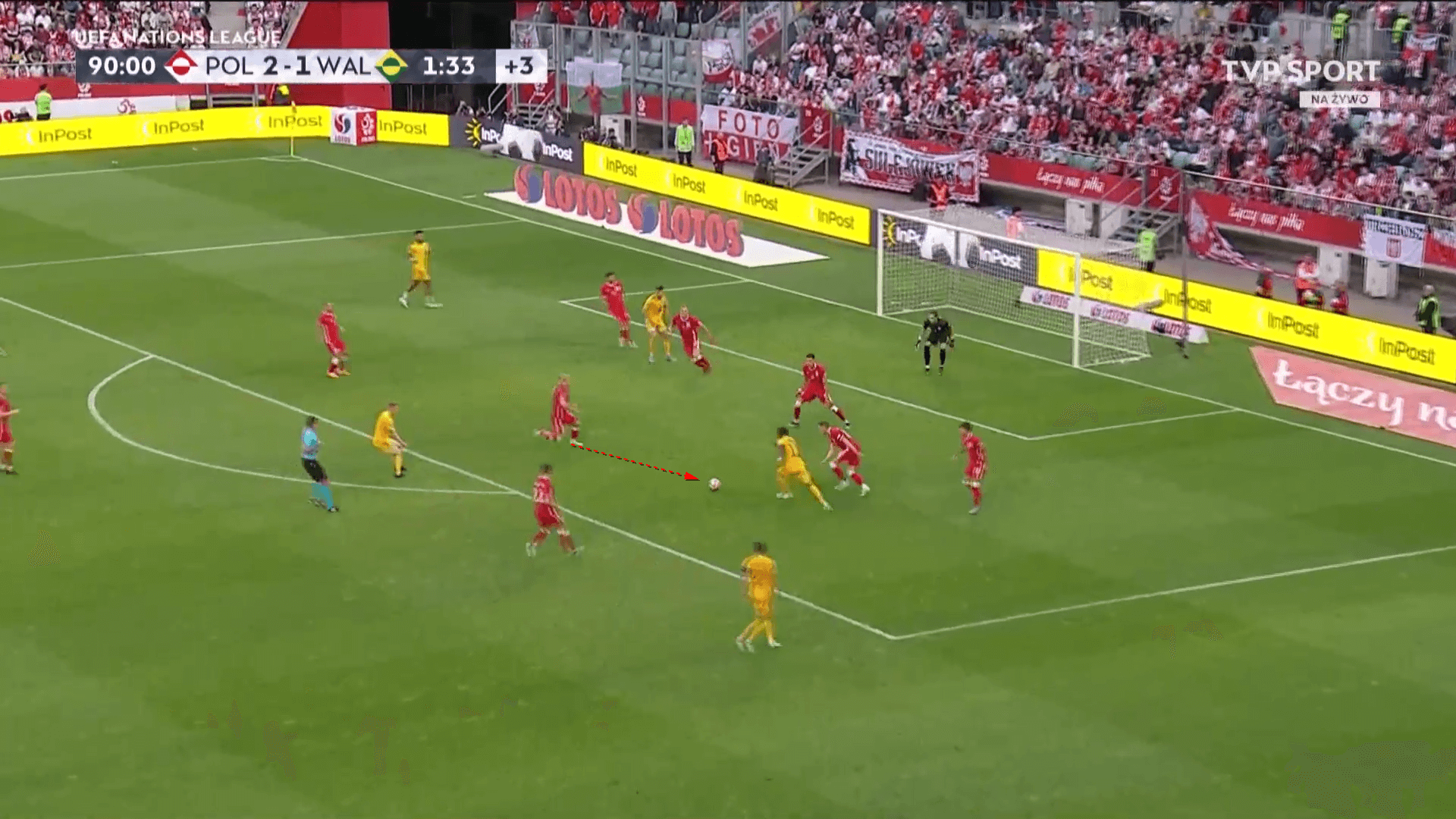
Impact at Rangers
The right-winger position has been a struggle to fill at Rangers. Scott Wright and recent unsuccessful arrivals of Fashion Sakala and Manchester United’s Amad Diallo are just some of the players van Bronckhorst has used to help the void since Ianis Hagi’s ACL injury in January. With nine goal involvements last season, Wright’s output could be improved upon next season for Rangers as they look to reclaim the Scottish Premiership and impress in Europe. This improvement could come in the form of Rabbi Matondo.
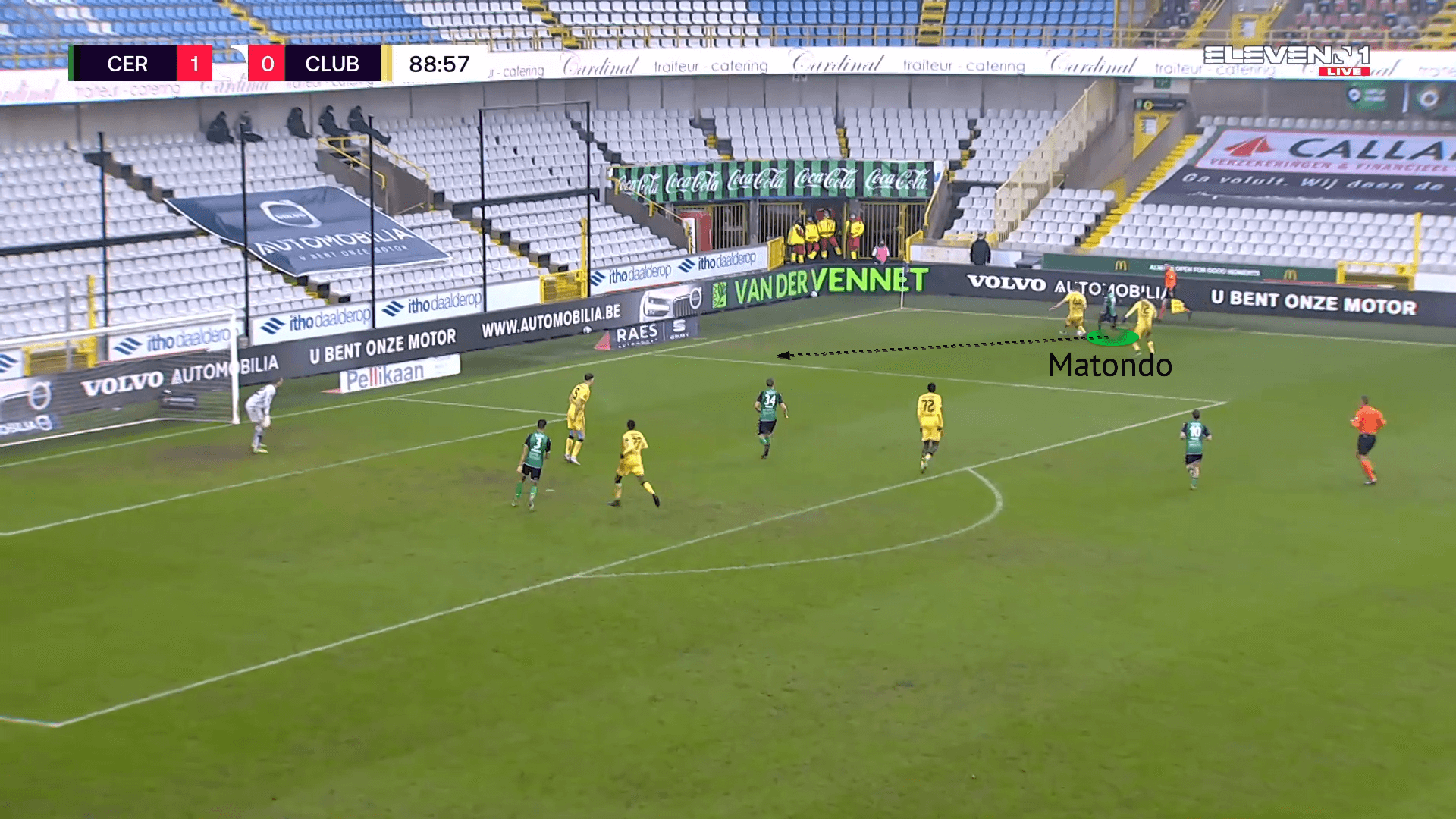
With Alfredo Morelos’ fantastic box movement and anticipation, Matondo’s assist tally should increase with a role on the right-wing as opposed to his left-wing role at Cercle Brugge. Although Matondo’s crossing is not one of his strong points, the striker’s movements will help get the best out of it. New signing Antonio Colak’s positioning between the posts is excellent for a striker and the pair combining could lead to them settling in quickly.
The images above and below display the previously mentioned assist from Matondo in the derby against Club Brugge. Isolated on the right-wing against left-sided defenders Eduard Sobol and Brandon Mechele, Matondo uses his pace and dribbling to squeeze between the defenders and get to the by-line by nutmegging Mechele. The Wales international continues to drive to the six-yard-box and set up a tap-in for David Sousa, between the posts in a typical position for Rangers’ strikers.
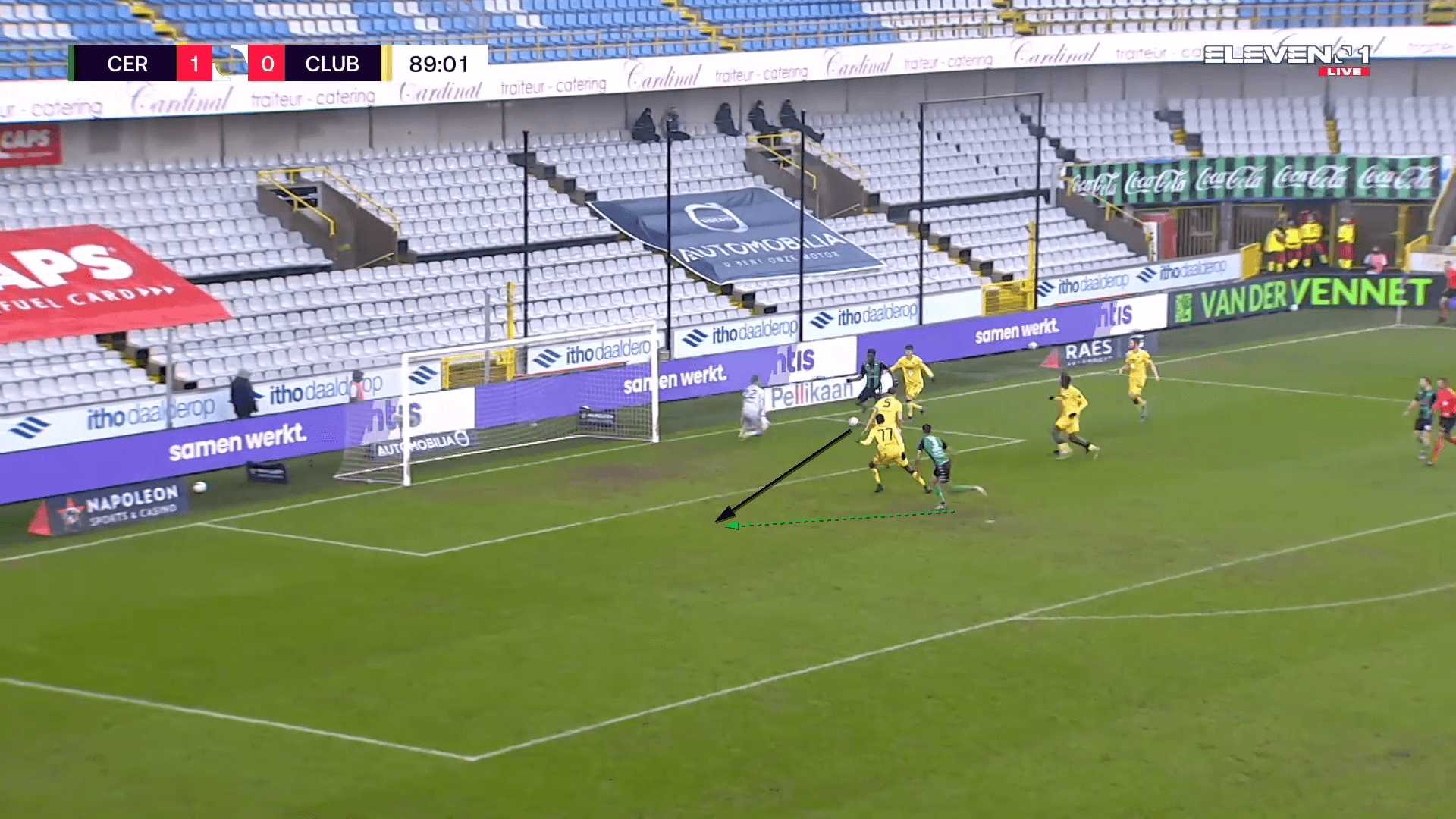
However, his role at Rangers may not involve many situations where he is up against defenders in the widest right channel. Towards the last few months of the 2021/22 season, van Bronckhorst shifted to an asymmetric shape with Ryan Kent staying wide on the left and the right-winger occupying a narrower position, allowing right-back James Tavernier to have creative freedom on the right.
Saturday’s friendly win at Blackpool gave us the first real glimpse of Rangers’ pre-season and any adjustments from van Bronckhorst ahead of the upcoming season. The positioning of the wingers struck similarities to Steven Gerrard’s spell at the club with narrow wingers. The set-up saw the two wingers (mainly Kent and Wright) occupying central areas with full-backs Tavernier and Borna Barišić remaining wide.
The full-backs looked to balance between overlapping and staying inside. This potentially allows Matondo, if deployed at right-winger, to operate wide and isolate an opponent with the right-back staying infield. The winger discovery at Blackpool could begin to question whether Matondo would be best suited to the winger role on the right or the left, which is similar to his positioning at Cercle Brugge. At Blackpool, the wingers could be seen receiving with their back to goal in a narrow position.
Despite some issues with receiving with his back to goal, if Rangers can find Matondo in these positions that allow him to drive at the opposition defence, he could become dangerous in this set-up. His ball-carrying and explosiveness provide a different option on the right-wing for van Bronckhorst’s squad.
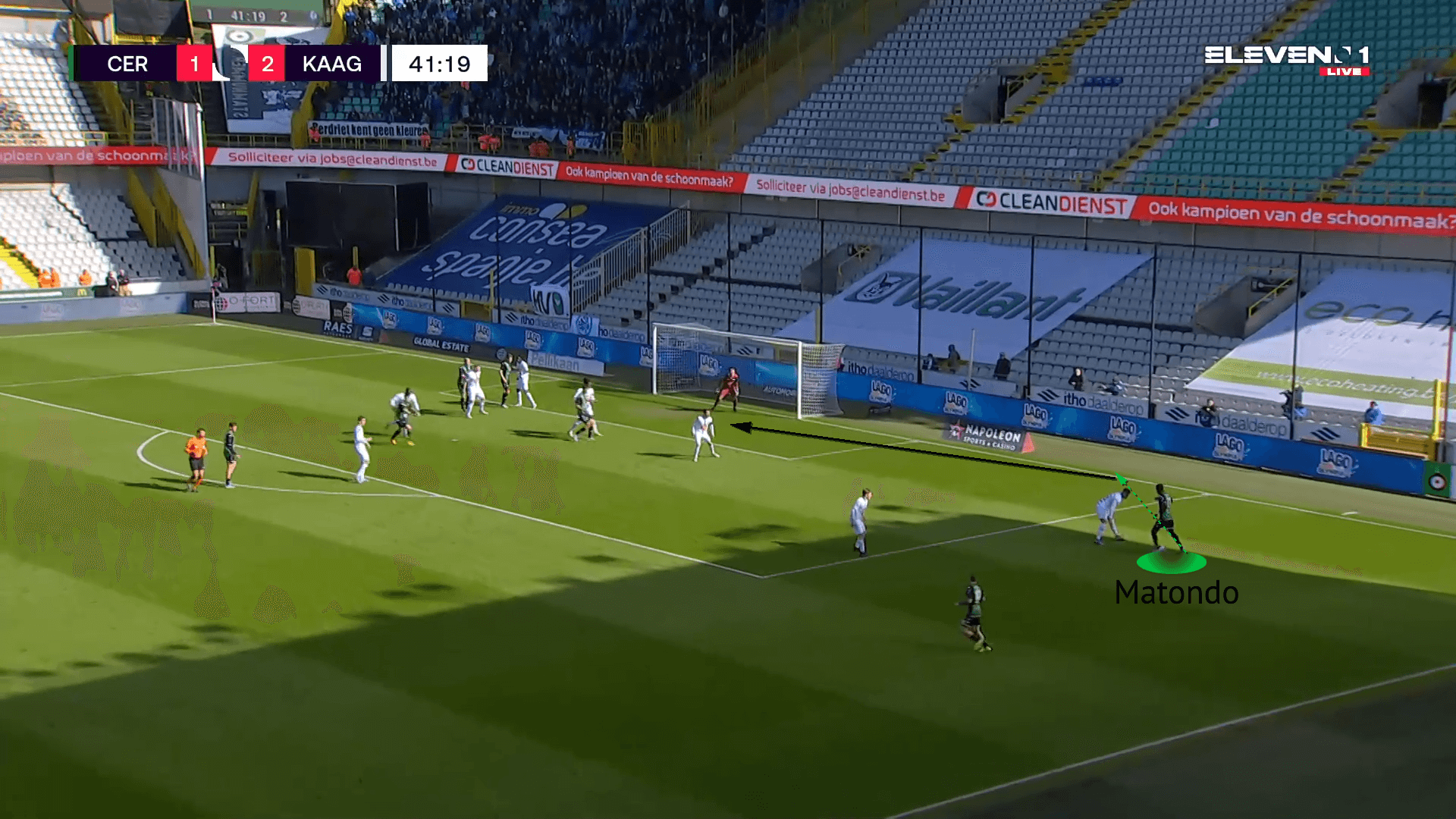
Matondo could also provide a different option for Rangers from corners. Typically, Tavernier and Barišić would deliver whipped corners into the box, with success from flick-ons towards the back-post. If The Gers wanted to switch up their corner routines, the arrival of Matondo could help this.
At Cercle Brugge, the Wales international would offer a short corner option, particularly on the right. The image above is an example of Matondo receiving a short corner and using his burst of pace and dribbling on the right to beat his man and deliver a hard and low cross. His ability to beat his man can be used in the 1vs1 situations and has also forced the opposition to take an extra player out of the box in an attempt to nullify and prevent Matondo from receiving and beating his man.
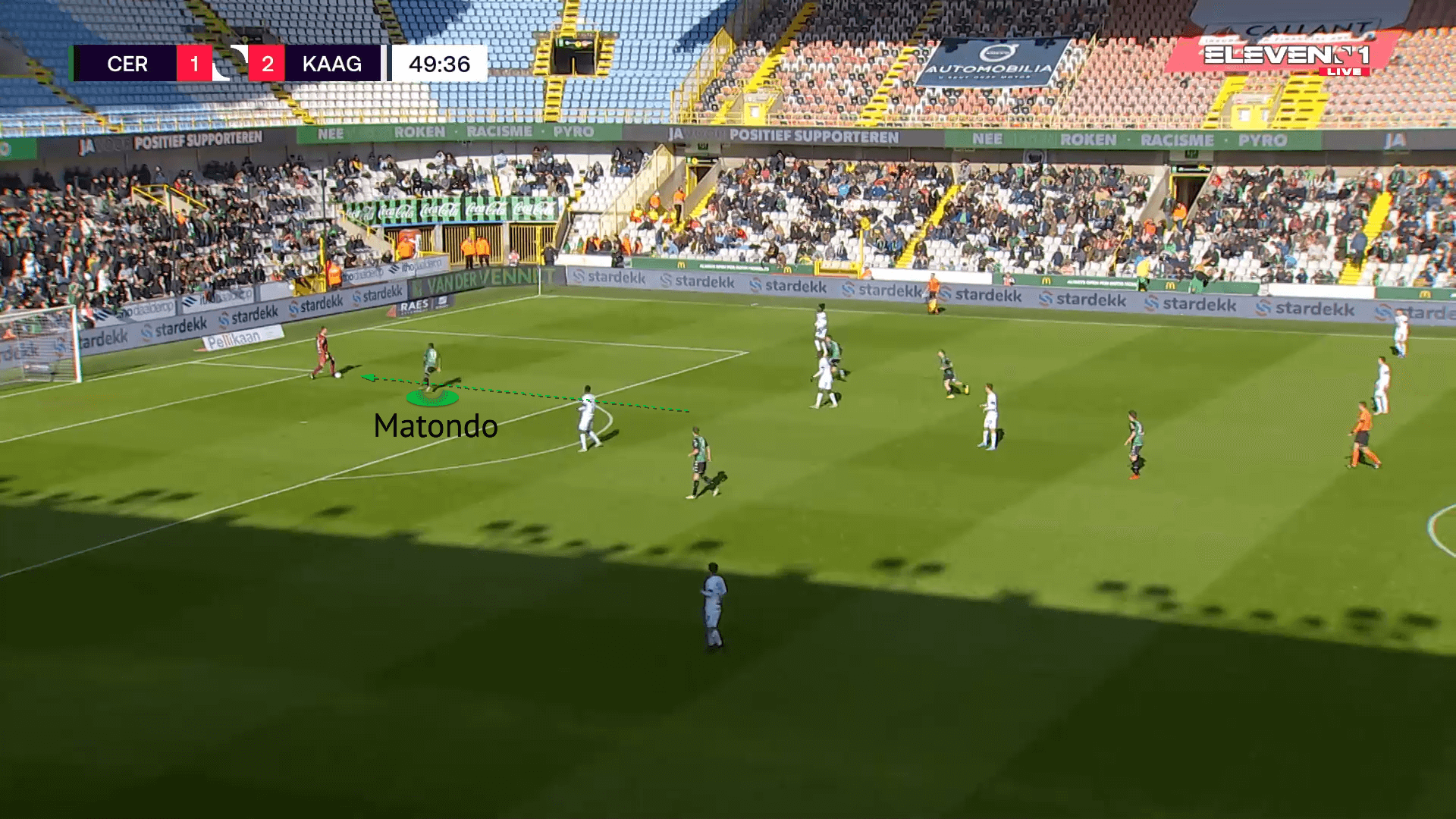
These images show Matondo using his pace defensively. With a PPDA of 7.86, Rangers ranked 2nd in the league last season. Alongside the 3rd highest challenge intensity, van Bronckhorst’s side will deploy an intense press. Matondo’s quickness could be used effectively when closing down opponents and creating pressing traps to force play a certain way. The image above shows Rangers’ new signing pressing the Gent goalkeeper Davy Roef and tackling the goalkeeper before he can clear the danger. After regaining possession, Matondo attempted a blind pass across the goal rather than the cut-back for a near-certain goal.
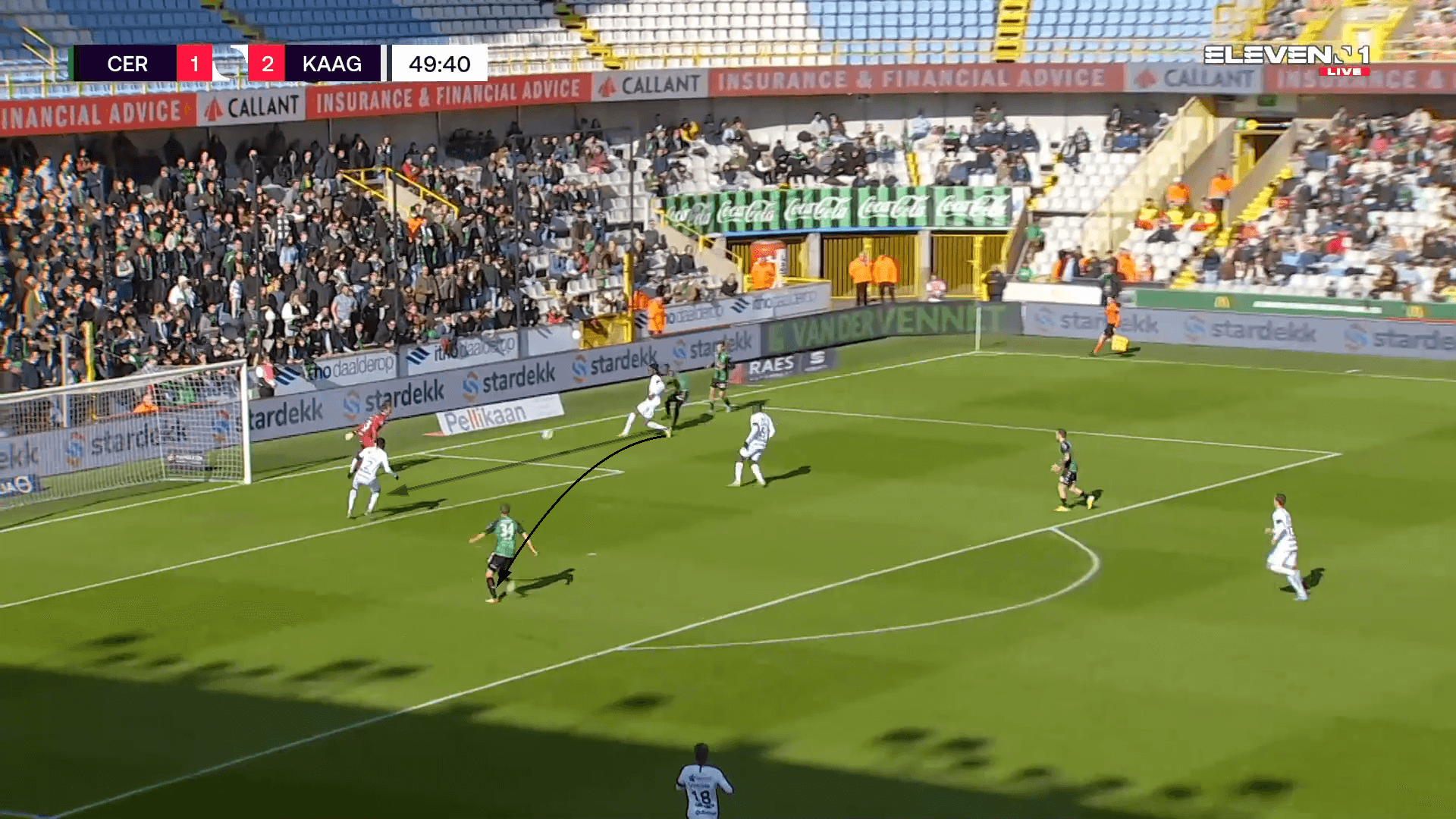
Conclusion
The signing of Rabbi Matondo will excite Rangers supporters, with his directness and lightning-quick pace and dribbling enough to threaten any defence. His experience in new leagues and internationally with Wales will be crucial to helping him adapt as he looks to have an impact at Rangers.
Even if he is not able to tie down a starter role immediately, the new signing would remain a fearsome option off the bench. Allowing a potential change in approach in games, his endurance and willingness to stretch play could be particularly effective in chaotic, transition-heavy games in European competitions.
It will be interesting to see if van Bronckhorst continues with the set-up we saw at Blackpool with the wingers occupying narrower positions. It would bring Matondo closer to the goal, with his performances at Cercle Brugge showing his eye for scoring. This system could also work well for new arrivals Tom Lawrence and Bayern Munich’s Malik Tillman, who both have experience operating wide and centrally. Either way, the skill set Matondo provides is certain to disrupt defences regardless of the system and role Rangers deploy next season.
In this analysis, we have looked at Rabbi Matondo’s influence on loan at Cercle Brugge last season, identifying his pace and dribbling as key components to his game. We have also looked at how he could impact Rangers and their tactics next season as they look to take back the Scottish Premiership title and continue to impress in Europe.






Comments